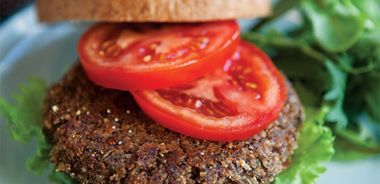Black Bean Veggie Burgers with Sesame Sauce

These burgers are full of nutritious ingredients, and they freeze easily. Serve them with sesame sauce (recipe included) or with regular burger condiments. This recipe can also be used to make beanballs for pasta and “meatballs”; just shape into balls instead of burgers, brush them with oil, and bake at 375 F (190 C) until golden brown.
Burgers
1/4 cup (60 mL) low-sodium vegetable broth
4 white onions, chopped
4 bell peppers, any colour, chopped
4 cups (1 L) chopped button mushrooms
8 cups (2 L) cooked black beans
2 cups (500 mL) unsalted mixed nuts, toasted
8 slices of whole grain toast
Juice of 4 lemons
2 Tbsp (30 mL) yellow or Dijon mustard
2 Tbsp (30 mL) dried oregano, thyme, or parsley, or 1/2 cup (125 mL) chopped fresh herbs
4 tsp to 3 Tbsp (20 to 45 mL) Montreal steak spice (see recipe to make your own)
Cumin and cinnamon, to taste
1 cup (250 mL) cornmeal
1/2 Tbsp (7 mL) extra-virgin olive oil
Sesame Sauce
3/4 cup (180 mL) sesame seeds, toasted
1 tsp (5 mL) low-sodium soy sauce
Juice of 2 lemons
2 Tbsp (30 mL) honey
2 Tbsp (30 mL) sweet red chili sauce
Salt and pepper, to taste
Heat vegetable broth in very large skillet or wok; sauté onion in it until translucent. Add peppers and mushrooms and continue to sauté until cooked.
Transfer vegetables to mixing bowl and add black beans. Use handheld blender to blend bean and vegetable mixture until a chunky purée is formed.
In coffee grinder, grind toasted nuts into a flour or paste and grind whole grain toast into bread crumbs.
Stir nuts and bread crumbs, lemon juice, mustard, herbs, Montreal steak spice, cumin, and cinnamon into bean and vegetable mixture. Form approximately 18 burgers out of the mixture.
If mixture is too wet, add more bread crumbs until you can form burgers easily. If mixture is too chunky, blend into a smoother purée.
To cook:
Spread generous amount of cornmeal on small plate and dredge burgers. Cook in skillet, coated with enough oil to prevent sticking, over medium heat until golden brown on both sides.
While burgers are cooking, make sauce. In coffee grinder, grind sesame seeds into smooth paste. Blend sesame seed paste with soy sauce, lemon juice, honey, sweet red chili sauce, salt, and pepper.
To store:
Burger mixture can be stored, uncooked, in an airtight container in the fridge (for 3 to 4 days) or freezer (for 2 to 3 months) until ready to use.
Store cooked burgers, once cooled, in fridge or freezer in an airtight container, arranging them to avoid sticking together, with waxed paper separating burgers.
Makes 18 servings.
Each serving contains: 236 calories; 9 g protein; 14 g total fat (2 g sat. fat, 0 g trans fat); 24 g total carbohydrates (5 g sugars, 6 g dietary fibre); 316 mg sodium
Many nonorganic spices are irradiated to kill micro-organisms. If you prefer to buy non-irradiated spices, you may find Montreal spice mix in your local health food store—or you can simply make it yourself using organic spices. Sprinkle it on pretty much any dish for an added boost of flavour.
To make your own seasoning, mix together:
2 Tbsp (30 mL) paprika
2 Tbsp (30 mL) black pepper
2 Tbsp (30 mL) kosher salt
1 Tbsp (15 mL) garlic powder
1 Tbsp (15 mL) onion powder
1 Tbsp (15 mL) ground coriander
1 Tbsp (15 mL) dill
1 Tbsp (15 mL) red pepper flakes
Store leftover Montreal spice mix in a glass jar with airtight lid.
source: "Healthy Make-Ahead Meals", alive #361, November 2012




